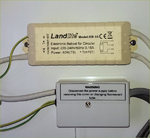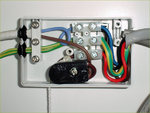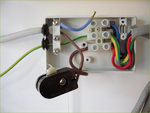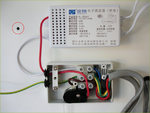Homebase round mirror inverter repair (Part 2)
AVAILABILITY OF THE INVERTERS MENTIONED BELOW IS BECOMING MORE DIFFICULT. SEE NOTES AT THE END REGARDING SUGGESTED ATERNATIVES, ALSO PLEASE BROWSE ON AMAZON FOR OTHERS SIMILAR TO THE ONES SUGGESTED.
To recap, having swapped the light tube only to find it still wouldn’t light, I discovered that the original electronic ballasts are no longer made, not even by Landlite. It's this that gives the light its instant-on feature without any flickering, but it seems the EB-56 ballast is prone to failure and a few people have had problems with them.
Rewiring the whole lot using a traditional ballast and starter isn't trivial. The only other option is to try a Chinese-made 40W circular fluorescent tube inverter instead, and the very thing was being sold on Amazon. Otherwise, consider upgrading to a more modern and reliable LED bathroom mirror such as these LED Bathroom Mirrors on Amazon.
 Comparing Landlite EB-56 inverter (click to enlarge)As they're not as big or heavy as the original Landlite EB-56, they’ll fit inside the mirror without a problem. Read on...
Comparing Landlite EB-56 inverter (click to enlarge)As they're not as big or heavy as the original Landlite EB-56, they’ll fit inside the mirror without a problem. Read on...
DIY instructions to repair a faulty Homebase mirror lamp inverter
Switch off the mains at the fusebox, or switch off the relevant ring-mains or (in my case) lighting circuit breaker. If the mirror’s above a sink, put the plug in the plughole in case any screws fall in.
Remove the four screws holding the glass on the metal base, and gently pull off the mirror.
 Mirror removed, revealing the tube and inverter (click to enlarge)
Mirror removed, revealing the tube and inverter (click to enlarge)
 Landlite EB-56 inverter and terminal block (click to enlarge)Unscrew the terminal block cover, loosen the cable cord grip screws and disconnect the Live (brown) and Neutral (blue) wires going to the old inverter. As the Live goes to the pull-switch, that must be unscrewed to get to the screw terminal, while Neutral goes to the main terminal block.
Landlite EB-56 inverter and terminal block (click to enlarge)Unscrew the terminal block cover, loosen the cable cord grip screws and disconnect the Live (brown) and Neutral (blue) wires going to the old inverter. As the Live goes to the pull-switch, that must be unscrewed to get to the screw terminal, while Neutral goes to the main terminal block.
 Terminal block and pull-switch housing (click to enlarge)Also disconnect the Earth (green/ yellow) wire that goes to the old inverter. Leave the light’s main earth wire in place, safely connecting the light's metal chassis to the Earth terminal block.
Terminal block and pull-switch housing (click to enlarge)Also disconnect the Earth (green/ yellow) wire that goes to the old inverter. Leave the light’s main earth wire in place, safely connecting the light's metal chassis to the Earth terminal block.
 Remove the old inverter's Earth, Neutral and Live wires. The pull-switch has to be unscrewed to access the Live terminal (click to enlarge)
Remove the old inverter's Earth, Neutral and Live wires. The pull-switch has to be unscrewed to access the Live terminal (click to enlarge)
 Terminal block minus the old inverter's wiring (click to enlarge)
Terminal block minus the old inverter's wiring (click to enlarge)
Note the replacement inverter needs no Earth wire; that’s OK as the old Landlite inverter simply had extra filter circuitry connecting to Earth.
Pull off the fluorescent tube’s connector plug. Remove the two mounting screws and the old inverter will come away.
 The old inverter removed. The lamp's earth wire remains connected as shown (click to enlarge)
The old inverter removed. The lamp's earth wire remains connected as shown (click to enlarge)
My new inverter was smaller and didn't fit the two existing mounting holes. Typical. As it only weighs a third of the original one, I decided to mount it using the original screw on the right handside only. The other option is to drill and tap a new hole in the base for the inverter’s lefthand mounting tab, which I thought was over-elaborate as the new inverter is fairly lightweight and it isn't going anywhere.
 The new inverter in situ, held down with one screw. Unused screwhole circled in red. (click to enlarge)
The new inverter in situ, held down with one screw. Unused screwhole circled in red. (click to enlarge)
Connect the new inverter’s Live (red) wire to the pull-switch, feeding it through the cable grommet and cable grip in the terminal block. Connect the Neutral (white) directly to the Neutral screw terminal block. Ensure none of the wires is trapped anywhere when the pull-switch is screwed back down, and that the switch operates smoothly without the cord jamming. Again, double check the light's earth wire is still connected properly to the main terminal block.
 New inverter in place and the tube is reconnected. Note the earth wire. (click to enlarge)
New inverter in place and the tube is reconnected. Note the earth wire. (click to enlarge)
The fluoresecent tube can be reconnected, moving it around on its clips if necessary so the inverter’s connector lead can reach it. Finally, replace the terminal block cover. You can now turn on the mains and test the lamp.
 After re-assembling the terminal cover, turn on at the mains and test (click to enlarge)
After re-assembling the terminal cover, turn on at the mains and test (click to enlarge)
Finally, check the rubber seal going around the edge is located properly to protect against moisture, and then the mirror can be screwed back into place. Job done!
This low cost inverter has given the light a new lease of life.

- Information was correct at time of writing, 13th Feb. 2014
- Also see my piece on upgrading a 32W Circline ring fluorescent ceiling light here
These electronic ballasts are popular but vendors come and go on Amazon, try the links below and use one that works for you.
Typical 22-40W circular fluorescent tube electronic ballast - https://amzn.to/3IGEqMH
Othmro Electronic Ballast 22-40W 220V 2PCS,Fluorescent Lamp Ballasts Replacements for Lamp Ballast - https://amzn.to/3TlBcmH
The above Amazon Affiliate links help towards the annual cost of this web site, which runs at a loss.
These are alternatives, but you might have to sort out a little bit of mains wiring youself if wires are too short, or there may be no connector included. The critical thing is the ‘square’ type (2 x 2 pins arranged in a square) fluorescent tube connector (also called a G10q fitting), the output power needs to be rated at 40W and ideally have sufficiently long wires so you don’t have to rig up some extension wiring.
 consumer tagged
consumer tagged  Homebase circular mirror,
Homebase circular mirror,  fluorescent inverter
fluorescent inverter 